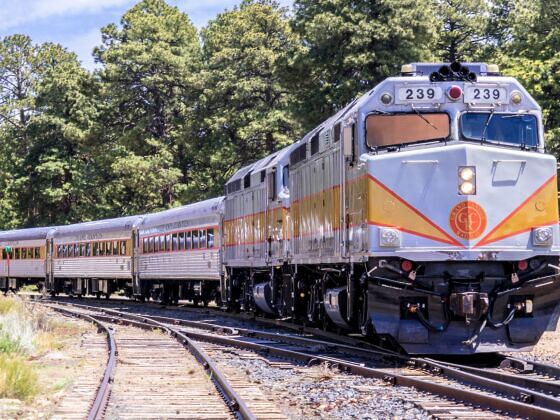Not content with keeping around 60,000 cars out of the Grand Canyon National Park every year, the Grand Canyon Railway (GCR) has been embracing sustainable initiatives for decades. Since 2009, the GCR has been using recycled vegetable oil as fuel for their two steam locomotives, and starting in 2027, the railroad will begin operating a zero-emission, battery-powered locomotive.


One of the Most Iconic Train Rides in the Country Is Going Electric
The Grand Canyon Railway (GCR), which started taking tourists to the Grand Canyon nearly 125 years ago on September 17, 1901, is not a small operation. It owns 15 diesel locomotive, five of which are in daily service, and two steam locomotives which run 13 days every year.
Of the 15 locomotives owned by GCR, it’s an F-40 model, of which it has eight, that will be converted from diesel to battery-electric power. According to a spokesperson for GCR, it’s the railroad’s current mechanical staff of about 25 people who will take care of the conversion, alongside an outside contractor who will be training the employees on how to build and maintain the battery-electric locomotive.
While the project is already underway, it won’t happen overnight. Acquiring materials for the conversion will take about one year, and the construction will take another year after that. That means that GCR’s battery-electric locomotive will not be in service before 2027.
Once the conversion is done and the locomotive is up and running, it will be able to make one 128-mile, round trip between Williams, Arizona, and the South Rim of the Grand Canyon on a charge. The batteries that will soon be installed in the locomotives are expected to last 12 long years, after which they can be replaced for another set that will last another dozen years.
Not only will the ride from Williams, Arizona to the South Rim of the Grand Canyon be better for the planet, but passengers can expect a more silent and less smelly ride as there won’t be any diesel exhaust. Also, the GCR is expected to “save a significant amount of fuel for the railway” and “reduce maintenance costs and improve reliability,” a spokesperson for GCR explains in an email.
This project is funded thanks to $3.4 million grant obtained in October 2024 from US Department of Transportation’s CRISI grant program. (CRISI stands for Consolidated Rail Infrastructure and Safety Improvements.) The grant will cover 80 percent of the cost of the project and the railroad will cover the remaining 20 percent.
Today, according to GCR, more than 225,000 passengers, i.e. about seven percent visitors to the South Rim, choose to travel there by rail. The 64-mile, one-way trip takes 2.25 hours and starts at $34.99 per adult each way in Pullman Class, the cheapest of the six classes of service available.